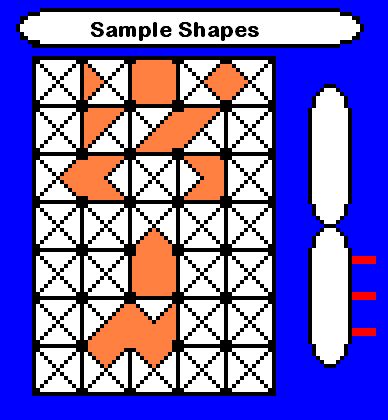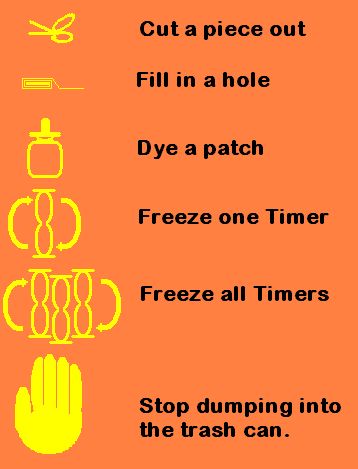GCPP:Proposal-Salmon
Puzzle Codename: Salmon
| Contact | |
| Username: | Alleahswiki Alleahswiki |
| Additional contact info: | On All Oceans as Alleah (Primary Colbalt), mscrazyzonie on Yahoo!Messenger, Crazyzonie@yahoo.com |
| Project forum thread: | Discussion |
Game concept
A pattern filling puzzle for the Tailoring crafting jobs, based on the same game play as in Puzzle Inlay. It is similar to Carpentry puzzle, but involves geometric shapes based on triangles and squares. Players place cloth patches into patterns to create clothes for the order rack, while trying to avoid orders being canceled and cloth patches being wasted.
Objective
Fill the allotted number of orders on the rack by filling in multiple template windows, without the wasting cloth patches and letting time run out on individual orders (causing the order to be "canceled").
Gameplay
The screen consists of an "Order's Rack" with hangers for "Pending Orders", the game field with places for four to six "orders", a table with a trash bin next to it at one end and an optional toolbox on the side of the screen. Each order box consists of a "pattern" placed over a grid field with an accompanying hour glass timer to the right. The pattern consists of the shape of an article of clothing (shirt, trousers, skirt, dress, bandana, etc.) fitted to the grid. On the "Table", cloth shapes, called patches" is pushed out on the table left to right by new patches that appear to the left at a regular interval. If the patch should be pushed all the way to the end of the table and is pushed off the table, it falls into the trash bin as a wasted piece. When pieces are pulled from the table, a space is left to be filled. Pieces can only be pushed by pieces coming in from the left, so new pieces would fill the spaces before pushing the end piece off the table. (If the player accidentally picked up a piece, and there is a space on the table, then the player could put the piece back on the table.
The players grab patches from the table, rotate and place them into one of the patterns in the center of the screen. Unlike carpentry, Patches cannot be placed outside of the pattern or over another patch. When all of the spots in the pattern are filled or the sand in the order timer runs out, then the order is moved to the rack. (A pattern that is not filled in the allotted time is called a "Canceled Order".) Each pattern will also be shaded in dark and light gray areas for bonus scoring opportunities. When an order is either completed (pattern filled) or canceled (time runs out), the order box is moved to the rack, and a new order box with a random pattern is put in the old order's place.
The grid is formed by a series of squares divided into four triangles. (Take a box, and draw an "X" through it.) The triangles in the grid are the base geometric shape used in the puzzle that the rest of the shapes are built from. Each grid should be no more than five squares wide by seven squares tall (for 140 total triangles), even though the patterns will not use the entire grid. Pattern size can vary with shape chosen, to create a library of easy to complex patterns the system can use. Pattern size can be used to vary the amount of time in the timer, by multiplying the number of triangles with a base time value. (Example: simple pattern shapes should require 15 seconds per triangle on average to complete.) The grid does not have to show on the pattern.
The "patches" or playing pieces consist of one or more triangles connected along their sides with each other using one solid color. Shapes created by connecting corners without a touching sides are not allowed. Shape colors should be a simple range starting with black, white, tan and brown, then adding more colors as the level of difficulty increases. Some pieces will have tools attached to them. When pieces with tools are played, the tool is tossed into the toolbox for later use. Patches vary in ease of use from basic (one unit triangle), simple (two unit triangles, two unit diamonds, four unit squares, four unit parallelograms, and four unit trapezoids), geometric (pentagons, hexagons, etc.), to abstract (three unit almost squares, "s" and "c" pieces, etc.)
Tools should be rare to appear, but allow players to get out of tight jams. Tools could include such items as Scissors to cut out unwanted parts of a patch, an Hourglass to extend the timer on one order, a Bottle of Dye to make a color patch match that of another one it touches, a Wrench to pause the dumping of patches into the trash, and a Knife and Cloth to fill in a limited number of squares of any shape (as long as they connect). Each tool is used by dragging it to the area it affects and dropping it. There are no points given for using the tools, but they should help the player to complete the patterns and avoid penalties. All tools are used one time, but players can collect more than just one of the same tool.
A training mode can be developed by starting with one pattern (trousers) and limiting pieces to the basic tile set with four colors. Next level can be an expanded tile set, then two patterns, etc.
Scoring
Players should earn some points (minimal) for placing cloth patches on to the patterns, but the mainstay of the points should be earned by completing the patterns. Players should incur penalties for letting pieces fall into the trash and time running out on patterns (canceled orders). Bonus points can be awarded to players who use 1/2 to 1/4 of their allotted time to complete a puzzle, to using one color in a pattern, or matching the dichromatic color pattern inside the pattern (i.e. only one color used in the light gray areas, and another for the dark gray areas).
The end game scoring averages the points earned over the amount of time spent in the puzzle, and compares that average to a scale used to determine the quality of work (basic, skilled, and expert) as well as the level the puzzle was played at (booched, poor, fine, good, excellent, and incredible).
Variability
Special tools appear to help players out of tight spots. (See tools in the game play section.)
End criteria
The order rack is filled. The allotted number of orders is completed when there are no empty hangers on the rack.
Difficulty scaling
At higher skill ratings, more complex patterns appear in the orders window, more abstract shapes appear on the table, and more possible colors for pieces are added. Maybe at the legendary and ultimate levels, introduce two-color pieces.
Bonuses (Special Tools)
These are bonus tools a player can earn and then use in the game. Each tool is used once per tool selected, but a player can collect more than one of each tool. Tools are ranked in order of appearance, with the most frequent at the top. Any tool that affects one or more timer on the board does so for a limited amount of time. Tools only aide the player in scoring higher, but to not give points by themselves.
Scissors: This would allow the player to cut out an unwanted part of a pattern played.
Bolt of Fabric: This would allow the player fill in a small part of the pattern. Only applies to the empty areas of the pattern.
Bottle of Dye: This would allow the player to change the color of a patch of cloth already played.
Flip Timer: This would allow the player to reset the hour glass on one order only. (Could also freeze the timer instead.)
Flip All Timers: Same as Flip Timer, but applies to all active orders.
Stop Hand: This would stop the system from pushing patches of cloth into the trash. The system would still push new pieces as the player leaves empty spaces, and the player can still dump pieces in the trash.
Glossary of terms
Cloth Patch Game piece that the player will use to fill in the puzzle grid.
Patch Game Piece; see Cloth Patch.
Pattern The part of the puzzle that the player must fill with patches. Patterns include the outline and grey color pattern. Game pieces may not be placed outside of the pattern's boundaries.
Order The box containing a pattern and order timer. Also refers to the pattern itself.
Canceled Order An order where the order timer ran out. When the timer runs out, no more work can be done on the pattern.
Completed Order An order that was filled by the player. It moves to a hanger on the rack, and the completed order is replaced by a new order.
Rack The Completed Orders queue. The rack contains haangers to show how many orders are expected to be filled.
Hanger The slot for a completed order. If the hanger is empty, then it is waiting for an order to be completed. If there is a garment on the hanger, then the hanger has a completed order. (Works the same as the bottles in Alchemstery puzzle.)
Table The cloth patch queue. New patches are pushed on to the table from the left, then pushed off into the trashcan on the right of the table. If the player wished to drop a patch back on the table, and there is a free space, the player may do so, otherwise, the piece must be discarded.
Trash Can Where unwanted or unused game pieces are placed. Pieces can be pushed in from the table, or dropped by the player. Patches that land in the trash can are not retrieveable, and the player incurs a penalty for each patch that is dropped in, either by the table or by the player.
Tool Game pieces that let the player do one-time special activities. Tools can freese timers, removed parts of played patches, change the color of cloth patches, etc. However, specials are specific to types of tools. Tools are earned by playing special patches, and are stored in the toolbox.
Toolbox Where unused tools are stored.
Crafting type
Tailoring, but could also be adapted for the Furnishing stalls and shops.
Known problems
System requires separate timer events for each pattern in play and one for the table to introduce new pieces. This may induce performance issues into the game.
Notes
I will post images as I get time to create them. However, my art skills are lacking, therefore someone else should do the final art images. :D
The canceled orders do not have to go to the rack. They could also be left on the game, like the broken bottles in Alchemistry, or just removed from the board and replaced with a new puzzle. If the last methold is used, there could be a potential for a "never ending game" if the player cannot fill the rack with completed orders.
Main URL for Puzzle Inlay is http://www.gamehouse.com/gamedetails/?game=PuzzleInla&navpage=downloadgames
Images
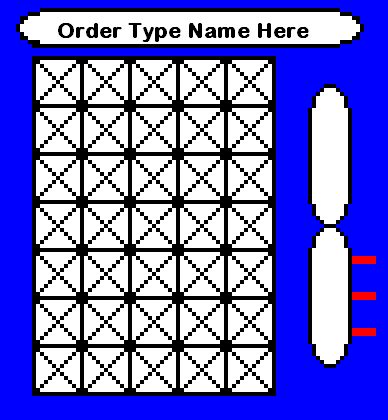 Sample order window with the game grid for the pattern and the timer.
Sample order window with the game grid for the pattern and the timer.
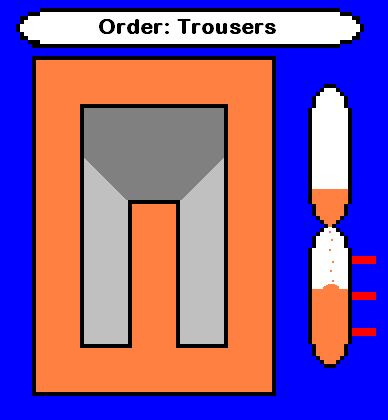 Sample order window with the trouser template loaded.
Sample order window with the trouser template loaded.
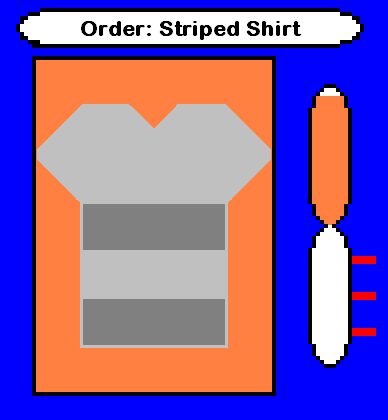 Sample order window wiht the shirt template loaded.
Sample order window wiht the shirt template loaded.
